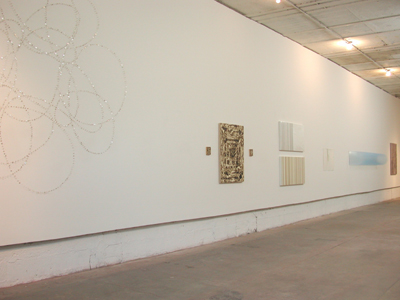Robin Hill: Approaching Perfection
Curated by Mery Lynn McCorckle
September 9 – October 9, 2003
The Brewery Project
676 South Ave. 21 #33
Los Angeles, CA
Artists include » Nancy Braver / Hovey Brock / Benicia Gantner / Robin Hill / Theodora Jones / Mery Lynn McCorkle / Barbara Nathanson / Katherine Powers / Greg Stone / Robert Winkler / Eric Zammitt
The Brewery Project presents “Approaching Perfection,” an exhibition of work by contemporary artists from New York City, North Carolina, the Bay Area and Los Angeles organized by Mery Lynn McCorkle.
She writes: “The eleven sculptors and painters in this show puzzle with harmony, working to create a dynamic calm from abstract elements. While each artist's work can be described as meditative or obsessive, each is dramatically different from the others.”
About the Project
“at the Brewery Project” was an independent downtown Los Angeles art space where a series of curated and artist-organized exhibitions for emerging and established artists was showcased during its ten-year existence. During its run, over 50 group exhibitions, exchanges with artists from 5 countries and ephemeral performance based works were presented at this unique site. The general directive was to provide a showcase where the diverse and different types of work present at any given time in the LA art world (and not necessarily a part of the market) could be seen and appreciated. The project space itself went through three distinct phases of operation, but always maintained a portion of the space that was ‘unfinished’ alongside the more traditional white spaces of the modern gallery. It ran from the fall of 1997 until the spring of 2007.
The project calendar was coordinated over the years by John O’Brien; but the independent curators or artist organizers who proposed them directed each exhibition. The exhibitions were set up, attended and run by the exhibiting artists themselves. The project was located in the historic 1904 John Parkinson “Edison Electric Building #3”, on the premises of The Brewery complex in downtown Los Angeles.
“at the Brewery Project” was preceded in time by Out of the Blue and the M*Y*T*H* exhibition series. The “M*ay Y*ou T*ravel H*eavenwards” series was dedicated to the memory of Mark Niblock-Smith, in particular, and to all those who died from the AIDS epidemic during that period. The M*Y*T*H* series ran from the fall of 1993 until the spring of 1994.
The “at the Brewery Project” and M*Y*T*H* exhibition series were made possible through the generosity of Kathleen Reges, Richard Carlson and Carlson Industries. “at the Brewery Project”, M*Y*T*H* and all the participating artists owe them an enormous debt of gratitude because they had faith in these artists and they had the foresight and willingness to provide the spaces and numerous amenities that made these projects possible.
“at the Brewery project” acknowledges the support of the Pasadena Art Alliance, the Los Angeles Department of Cultural Affairs and Oversight.com.
At the Brewery Project
1993 2007 - The Finale
Introduction: John O'Brien
Contributors: Wendy Adest, Jamison Carter, Jennifer Faist, April Durham, Karen Koblitz, Noel Korten,
Mara Lonner, Mery Lynn McCorkle,
Joseph Santarromana
Lawns say a great deal about the owner. Perfect lawns, no stray leaves, no weeds or bugs, everything water, fertilized, manicured are generally owned by conservatives (or the wealthy). This kind of perfection is about control, the dominance of man over nature. Perfection is also what advertisers sell. The perfect car, the perfect soap, the perfect attire, the perfect body. All promising perfect happiness. This perfection is also a form of control. It manipulates what others think, offering to help you manipulate what others think, while promising a control over any signs of mortality. The art selected for this exhibit explores a different kind of perfection, an attempt to achieve harmony. Perfect harmony requires a constancy not really possible in the constant changes of life. That's probably why harmony is essential in religious art and of less significance in our secular world. Art critics and historians tend to be somewhat embarrassed by any incursion of the religious, particularly western religions, into contemporary art which for the last century and a half has been expected to explode bourgeois conventions. Think of Mondrian's profound influence by Mme. Blavatsky's version of Christianity and the way it is hardly mentioned in discussions of his work. But I do think Mondrian's approach makes sense. Geometric shapes are the last of the universally recognized symbols not co-opted by advertising. They provide a way of talking about mass and energy without resorting to their ordinary manifestations. The artists in this show are not creating religious art but are trying to offer the viewer a meditative zone. If you give the work a chance, more time than the usual glance, they will try to take you to the sublime or at least offer a respite from the unrelenting haste of daily life. A place for perspective.
Mery Lynn McCorkle






